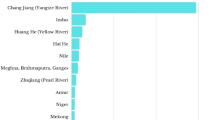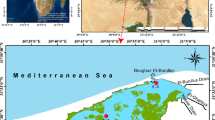Abstract
Purpose
As one component of the German ecological environment observation, the Environmental Specimen Bank program was initiated in the mid-1980s. Under the program, representative specimens of marine, fresh water, and terrestrial ecosystems are sampled regularly and archived under chemically stable conditions. An initial characterization of the samples provides data regarding the status quo of the respective ecosystems. The aim of the present publication is to give insight into these real-time monitoring data, which have been generated for the last 10 to 20 years. This is done exemplarily for the heavy metals cadmium (Cd), mercury (Hg), and lead (Pb) in marine specimens of the Baltic and the North Sea.
Methods
Bladder wrack (Fucus vesiculosus), blue mussel (Mytilus edulis), eelpout (Zoarces viviparus), and eggs of herring gulls (Larus argentatus) were sampled at one location in the Baltic Sea and at two sites in the North Sea (Schleswig-Holstein Wadden Sea and Lower Saxony Wadden Sea). Annual samples were pooled, homogenized, and analyzed for a set of elements. Cd and Pb were quantified after freeze-drying and microwave digestion using inductively coupled plasma-mass spectrometry. Total Hg in freeze-dried samples was determined by atomic absorption spectrometry using a direct mercury analyzer.
Results
Time series data covering up to two decades revealed comparable cadmium levels at all three locations. Concentrations in bladder wrack ranged between 0.10 and 0.37 µg/g on a wet weight basis (ww). Respective values for blue mussel and eelpout liver were 0.07–0.29 and 0.01–0.10 µg/g ww. Herring gull eggs were not included in cadmium analyses. Declining trends were observed in North Sea bladder wrack and mussels, eelpout from the Lower Saxony site, and mussels from the Baltic Sea. Upward trends were apparent in eelpout from the Schleswig-Holstein location. Mercury concentrations in Baltic Sea specimens ranged from 1.1–2.7 ng/g ww in bladder wrack to 2.6–5.1, 26–52, and 86–226 ng/g ww in blue mussel, eelpout muscle, and herring gull eggs, respectively. No temporal trends were observed. North Sea bladder wrack had accumulated 5.4–24 ng/g ww Hg. The respective Hg values for blue mussel and eelpout muscle were 19–64 and 73–187 ng/g ww. Highest Hg contents were detected in herring gull eggs (90–1,100 ng/g ww). Declining trends of Hg were observed in herring gull eggs at both North Sea locations and in blue mussels at the Lower Saxony site. Lead concentrations in Baltic Sea specimens were 48–222 ng/g ww in bladder wrack, 85–189 ng/g ww in blue mussel, 2.0–9.5 and 10–42 ng/g ww in eelpout muscle and liver, and 2.7–26 ng/g ww in herring gull eggs. In the North Sea, Pb concentrations were as follows: 68–397 ng/g ww in bladder wrack, 101–507 ng/g ww in blue mussels, 2.6–35 and 5.9–158 ng/g ww in eelpout muscle and liver, and 3.5–55 ng/g ww in herring gull eggs. Highest Pb-levels were found at the Lower Saxony site. Declining Pb-trends were observed in bladder wrack from the Baltic Sea; in bladder wrack and mussel at the Schleswig-Holstein location; and in bladder wrack, mussels, eelpout liver, and herring gull eggs at the Lower Saxony site.
Conclusions
During the 10 to 20 years of monitoring, reliable data were obtained which allow a good insight into metal contamination of marine biota. Assessment of the data according to OSPAR criteria (OSPAR 2005) revealed cadmium levels above the derived background concentrations in mussels of all three sites. Mercury levels above background concentrations were found at both North Sea locations, whereas only mussels at the Lower Saxony site had Pb concentrations above the reference value. Archived specimens are available for further analyses and questions which may arise in the future (speciation of elements, metallomics).


Similar content being viewed by others
References
Barwick M, Maher W (2003) Biotransference and biomagnification of selenium, copper, cadmium, zinc, arsenic and lead in a temperate seagrass ecosystem from Lake Macquarie Estuary, NSW, Australia. Mar Environ Res 56(4):471–502
Becker PH, Muñoz Cifuentes J (2004) Contaminants in bird eggs in the Wadden Sea. Spatial and temporal trends 1991-2000. Wadden Sea Ecosystems No. 18. Common Wadden Sea Secratariat (CWSS). http://www.waddensea-secretariat.org/news/documents/bird-eggs2004/WSE-18-cont-eggs-(01.03.05).pdf [Retrieved November 16, 2009]
Becker PH, Muñoz Cifuentes J, Behrends B, Schmieder KR (2001) Contaminants in bird eggs in the Wadden Sea. Spatial and temporal trends 1991-2000 Wadden Sea Ecosystems No. 11. Common Wadden Sea Secretariat, Trilateral Monitoring and Assessment Group, Wilhelmshaven, Germany. http://www.waddensea-secretariat.org/news/documents/bird-eggs2001/WSE-11-cont-eggs.pdf [Retrieved November 16, 2009]
Bignert A, Nyberg E, Asplund L, Eriksson U, Wilander A (2006) Comments concerning the National Swedish Contaminant Monitoring Programme in marine biota, 2006. Swedish Museum of Natural History, Stockholm
Bignert A, Nyberg E, Danielsson S (2007a) Cadmium concentrations in fish liver. HELCOM Indicator Fact Sheets 2007. Online, 29.10.2007. http://www.helcom.fi/environment2/ifs/archive/ifs2007/en_GB/cadmium_fish/ [Retrieved November 16, 2009]
Bignert A, Nyberg E, Danielsson S (2007b) Mercury concentrations in fish muscle. HELCOM Indicator Fact Sheets 2007. Online, 29.10.2007. http://www.helcom.fi/environment2/ifs/archive/ifs2007/en_GB/mercury_fish/ [Retrieved November 16, 2009]
Bignert A, Nyberg E, Danielsson S (2007c) Lead concentrations in fish liver. HELCOM Indicator Fact Sheets 2007. Online, 29.10.2007. http://www.helcom.fi/environment2/ifs/archive/ifs2007/en_GB/lead_fish/ [Retrieved November 16, 2009]
Bignert A, Nyberg E, Asplund L, Eriksson U, Wilander A, Haglund P (2007d) Comments concerning the National Swedish Contaminant Monitoring Programme in marine biota, 2007. Swedish Museum of Natural History, Stockholm
Bignert A, Nyberg E, Asplund L, Eriksson U, Wilander A, Haglund P (2009) Comments concerning the National Swedish Contaminant Monitoring Programme in marine biota, 2009. Swedish Museum of Natural History, Stockholm. http://www.nrm.se/download/18.6321786f122df65955f80002587/Marina+programmet+2009.pdf [Retrieved November 16, 2009]
Bovelander RW, Langenberg VT (2007) National Evaluation Report on the Joint Assessment and Monitoring Programme of the Netherlands 2005. Report RIKZ/2007.004, Feb. 2007, p 45
Burger J (1993) Metals in avian feathers: bioindicators of environmental pollution. Rev Environ Toxicol 5:203–311
Burger J, Gochfeld M (1995) Heavy metal and selenium concentrations in eggs of herring gulls (Larus argentatus): temporal differences from 1989 to 1994. Arch Environ Contam Toxicol 29(2):192–197
Cheung MS, Wang W-X (2008) Analyzing biomagnification of metals in different marine food webs using nitrogen isotopes. Mar Pollut Bull 56:2082–2105
Croteau M-N, Luoma SN, Stewart AR (2005) Trophic transfer of metals along freshwater food webs: evidence of cadmium biomagnification in nature. Limnol Oceanogr 50(5):1511–1519
Dobson J (2000) Long term trends in trace metals in biota in the Forth estuary, Scotland, 1981-1999. Mar Pollut Bull 40(12):1214–1220
Emons H, Schladot JD, Schwuger MJ (1997) Environmental Specimen Banking in Germany—present state and further challenges. Chemosphere 34(9/10):1875–1888
EU (2000) Directive 2000/60/EC of the European Parliament and of the Council of 23 October 2000 establishing a framework for the Community action in the field of water policy (Water Framework Directive) http://eur-lex.europa.eu/LexUriServ/LexUriServ.do?uri=OJ:L:2000:327:0001:0072:EN:PDF [Retrieved November 16, 2009]
EU (2006) Commission Regulation No 1881/2006 of 19 December 2006 setting maximum levels for certain contaminants in foodstuffs. http://eur-lex.europa.eu/LexUriServ/LexUriServ.do?uri=OJ:L:2006:364:0005:0024:EN:PDF [Retrieved November 16, 2009]
EU (2008a) Directive 2008/56/EC of the European Parliament and of the Council of 17 June 2008 establishing a framework for community action in the field of marine environmental policy (Marine Strategy Framework Directive). http://eur-lex.europa.eu/LexUriServ/LexUriServ.do?uri=OJ:L:2008:164:0019:0040:EN:PDF [Retrieved November 16, 2009]
EU (2008b) Directive 2008/105/EC of the European Parliament and of the Council of 16 December 2008 on environmental quality standards in the field of water policy, amending and subsequently repealing Council Directives 82/176/EEC, 83/513/EEC, 84/156/EEC, 84/491/EEC, 86/280/EEC and amending Directive 2000/60/EC of the European Parliament and of the Council. http://eur-lex.europa.eu/LexUriServ/LexUriServ.do?uri=OJ:L:2008:348:0084:0097:EN:PDF [Retrieved November 16, 2009]
Federal Environment Agency (2008) German Environmental Specimen Bank—concept, Berlin, Germany, 2008. http://www.umweltbundesamt.de/specimen/konzept/concept_oct_2008_en.pdf [Retrieved November 16, 2009]
Green N, Bjerkeng B, Hylland K, Ruus A, Rygg B (2003) Hazardous substances in the European marine environment: trends in metals and persistent organic pollutants. EEA Topic Report 2/2003, European Environment Agency (EEA), Copenhagen 2003, p 83 http://reports.eea.europa.eu/topic_report_2003_2/en/topic_no_2_2003_web_part_a.pdf [Retrieved November 16, 2009]
HELCOM (1992) Convention on the Protection of the Marine Environment of the Baltic Sea Area, 1992 (Helsinki Convention) http://www.helcom.fi/stc/files/Convention/Conv0704.pdf [Retrieved November 16, 2009]
Jara-Marini ME, Soto-Jiménez MF, Páez-Osuna F (2009) Trophic relationships and transference of cadmium, copper, lead and zinc in a subtropical coastal lagoon food web from SE Gulf of California. Chemosphere 77:1366–1373
Kenow KP, Meyer MW, Hines RK, Karasov WH (2007) Distribution and accumulation of mercury in tissues of captive-reared common loon (Gavia immer) chicks. Environ Toxicol Chem 26(5):1047–1055
Koppenaal DW, Hieftje GM (2007) Metallomics—the future of atomic spectroscopy? J Anal At Spectrom 22:111–111
MADS database (2008) The national database for marine data. National Environmental Research Institute NERI. http://www.dmu.dk/International/Water/MarineMonitoring/MADS/ [Retrieved November 16, 2009]
Mathews T, Fisher NS (2008) Evaluating the trophic transfer of cadmium, polonium, and methymercury in an estuarine food chain. Environ Toxicol Chem 27(5):1093–1101
Meeresumwelt (1999–2002a) Bund-Länder-Messprogramm für die Meeresumwelt von Nord- und Ostsee (BLMP) - Ostsee. http://www.bsh.de/de/Meeresdaten/Beobachtungen/BLMP-Messprogramm/PDF/Ber_99_02/ostsee9902d.pdf [Retrieved November 16, 2009]
Meeresumwelt (1999–2002b) Bund-Länder-Messprogramm für die Meeresumwelt von Nord- und Ostsee (BLMP) - Nordsee. http://www.bsh.de/de/Meeresdaten/Beobachtungen/BLMP-Messprogramm/PDF/Ber_99_02/nordsee9902c.pdf [Retrieved November 16, 2009]
Mesmar M (1987) Distribution of lead and cadmium in trophic levels of some marine organisms. Acta Biol Hung 38(1):155–160
Neff JM (2002) Bioaccumulation in marine organisms. Elsevier, Oxford, p 452
OSPAR (2005) OSPAR Agreement 2005-06, Agreement on Background Concentrations for Contaminants in Seawater, Biota and Sediment. OSPAR Commission. http://www.ospar.org/documents/dbase/decrecs/agreements/05-06e_agreement%20Bcs.doc [Retrieved November 16, 2009]
OSPAR (2007) List of Chemicals for Priority Action (Update 2007) (Ref. No 2004-12). OSPAR Commission. http://www.ospar.org/documents/dbase/decrecs/agreements/04-12e_List%20of%20Chemicals%20for%20Priority%20action.doc [Retrieved November 16, 2009]
Ostapczuk P, Burow M, May K, Mohl C, Froning M, Süßenbach B, Waidmann E, Emons H (1997) Mussels and algae as bioindicators for long-term tendencies of element pollution in marine ecosystems. Chemosphere 34(9/10):2049–2058
Rüdel H, Lepper P, Steinhanses J, Schröter-Kermani C (2003) Retrospective monitoring of organotin compounds in marine biota from 1985 to 1999. Results from the German environmental specimen bank. Environ Sci Technol 37:1731–1738
Rüdel H, Böhmer W, Schröter-Kermani C (2006) Retrospective monitoring of synthetic musk compounds in aquatic biota from German rivers and coastal areas. J Environ Monit 8:812–823
Rüdel H, Schröder W, von der Trenck KT, Wiesmüller GA (2009a) Substance-related environmental monitoring: work group ‘Environmental Monitoring’—position paper. Environ Sci Pollut Res Int 16(5):486–498
Rüdel H, Steinhanses J, Müller J, Schröter-Kermani C (2009b) Retrospektives Monitoring von Organozinnverbindungen in biologischen Proben aus Nord- und Ostsee - Sind die Anwendungsbeschränkungen erfolgreich? - BEITRAGSSERIE MEERESFORSCHUNG. Umweltwiss Schadst Forsch 21:282–291
Sato S, Okabe M, Emoto T, Kurasaki M, Kojima Y (1997) Restriction of cadmium transfer to eggs from laying hens exposed to cadmium. J Toxicol Environ Health 51(1):15–22
Schladot JD, Backhaus F, Ostapczuk P, Emons H (1997) Eel-pout (Zoarces viviparus) as a marine bioindicator. Chemosphere 34(9/10):2143–2152
Sell JL (1975) Cadmium and the laying hen: apparent absorption, tissue distribution and virtual absence of transfer into eggs. Poult Sci 54(5):1674–1678
Strom SM (2008) Total mercury and methylmercury residues in river otters (Lutra Canadensis) from Wisconsin. Arch Environ Contam Toxicol 54(3):546–554
Uhlig S, Simon K, Schick N, Köhler S, Rothmaler D (2002) Entwicklung statistischer Verfahren für Ringversuche, Methodenvalidierung und Auswertung von marinen Daten - Teilvorhaben II. Im Auftrag des Umweltbundesamtes. quo data - Gesellschaft für Qualitätsmanagement und Statistik mbH. Texte 35/02, Umweltbundesamt, Berlin. http://www.umweltdaten.de/publikationen/fpdf-l/2152.pdf [Retrieved November 16, 2009]
Umweltbundesamt (1996) Umweltprobenbank des Bundes - Verfahrensrichtlinien, Umweltbundesamt (ed) Erich Schmidt Verlag, Berlin
Umweltbundesamt (2009) Umweltprobenbank des Bundes/German Environmental Specimen Bank. www.umweltprobenbank.de or http://anubis.uba.de/wwwupb/servlet/upb?action=change_lang&language=0 [Retrieved November 16, 2009]
Voigt H-R (2007) Heavy metal (Hg, Cd, Zn) concentrations and condition of eelpout (Zoarces viviparus L.) around Baltic Sea. Polish J Environ Stud 16(6):909–917
Wenzel A, Böhmer W, Müller J, Rüdel H, Schröter-Kermani C (2004) Retrospective monitoring of alkylphenols and alkylphenol monoethoxylates in aquatic biota from 1985–2001: results from the German environmental specimen bank. Environ Sci Technol 38:1654–1661
Acknowledgements
The excellent technical assistance of Dirk Hansknecht, Diana Homrighausen, Annette König, Josef Schörmann, Heike Steinhanses, Sonja Uhlig, and Martin Weingärtner of the ESB team of Fraunhofer IME is gratefully acknowledged. Dr. Martin Müller is thanked for data management and statistical analyses.
Author information
Authors and Affiliations
Corresponding author
Additional information
Responsible editor: Thomas Braunbeck
Electronic supplementary material
Below is the link to the electronic supplementary material.
ESM 1
(DOC 88 kb)
Rights and permissions
About this article
Cite this article
Rüdel, H., Fliedner, A., Kösters, J. et al. Twenty years of elemental analysis of marine biota within the German Environmental Specimen Bank—a thorough look at the data. Environ Sci Pollut Res 17, 1025–1034 (2010). https://doi.org/10.1007/s11356-009-0280-8
Received:
Accepted:
Published:
Issue Date:
DOI: https://doi.org/10.1007/s11356-009-0280-8




